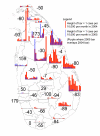Malaria in Sri Lanka: one year post-tsunami
- PMID: 16700913
- PMCID: PMC1475594
- DOI: 10.1186/1475-2875-5-42
Malaria in Sri Lanka: one year post-tsunami
Abstract
One year ago, the authors of this article reported in this journal on the malaria situation in Sri Lanka prior to the tsunami that hit on 26 December 2004, and estimated the likelihood of a post-tsunami malaria outbreak to be low. Malaria incidence has decreased in 2005 as compared to 2004 in most districts, including the ones that were hit hardest by the tsunami. The malaria incidence (aggregated for the whole country) in 2005 followed the downward trend that started in 2000. However, surveillance was somewhat affected by the tsunami in some coastal areas and the actual incidence in these areas may have been higher than recorded, although there were no indications of this and it is unlikely to have affected the overall trend significantly. The focus of national and international post tsunami malaria control efforts was supply of antimalarials, distribution of impregnated mosquito nets and increased monitoring in the affected area. Internationally donated antimalarials were either redundant or did not comply with national drug policy, however, few seem to have entered circulation outside government control. Despite distribution of mosquito nets, still a large population is relatively exposed to mosquito bites due to inadequate housing. There were no indications of increased malaria vector abundance. Overall it is concluded that the tsunami has not negatively influenced the malaria situation in Sri Lanka.
Figures


References
-
- Housing and Non Housing Building Units Damaged by the Tsunami 2004 Trincomalee District. 2006. http://www.statistics.gov.lk/Tsunami/final/Trincomalee/
-
- Sri Lanka: Facts regarding post-tsunami recovery six months on. 2005. http://www.reliefweb.int/rw/rwb.nsf/db900SID/KHII-6DY5LD
-
- Bonner B. Sri Lanka housing falling far short of goals. 2006. http://www.twincities.com/mld/pioneerpress/news/local/13787999.htm
Publication types
MeSH terms
Substances
LinkOut - more resources
Full Text Sources
Medical

